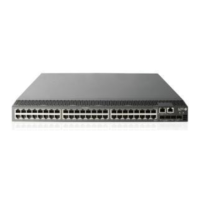55
Ste
Command
Remarks
3. Configure an SNMP
group and specify its
access right.
snmp-agent group v3 group-name
[ authentication | privacy ]
[ read-view read-view ] [ write-view
write-view ] [ notify-view
notify-view ] [ acl acl-number | acl
ipv6 ipv6-acl-number ] *
By default, no SNMP group is
configured.
4. Add a user to the SNMP
group.
snmp-agent usm-user v3 user-name
group-name [ [ cipher ]
authentication-mode { md5 | sha }
auth-password [ privacy-mode
{ 3des | aes128 | des56 }
priv-password ] ] [ acl acl-number |
acl ipv6 ipv6-acl-number ] *
N/A
Configuring SNMPv1 or SNMPv2c settings
Ste
Command
Remarks
1. Enter system view.
system-view N/A
2. Enable the SNMP agent.
snmp-agent
Optional.
By default, the SNMP agent
is disabled.
You can enable SNMP agent
with this command or any
command that begins with
snmp-agent.
3. Create or update MIB
view information.
snmp-agent mib-view { excluded | included }
view-name oid-tree [ mask mask-value ]
Optional.
By default, the MIB view
name is ViewDefault and
OID is 1.
4. Configure SNMP NMS
access right.
• (Method 1) Specify the SNMP NMS
access right directly by configuring an
SNMP community:
snmp-agent community { read | write }
community-name [ mib-view view-name ]
[ acl acl-number | acl ipv6
ipv6-acl-number ] *
• (Method 2) Configure an SNMP group
and add a user to the SNMP group:
a. snmp-agent group { v1 | v2c }
group-name [ read-view read-view ]
[ write-view write-view ] [ notify-view
notify-view ] [ acl acl-number | acl
ipv6 ipv6-acl-number ] *
b. snmp-agent usm-user { v1 | v2c }
user-name group-name [ acl
acl-number | acl ipv6
ipv6-acl-number ] *
Use either method.
The direct configuration
method is for SNMPv1 or
SNMPv2c. The community
name configured on the
NMS should be consistent
with the username configured
on the agent.
The indirect configuration
method is for SNMPv3.

